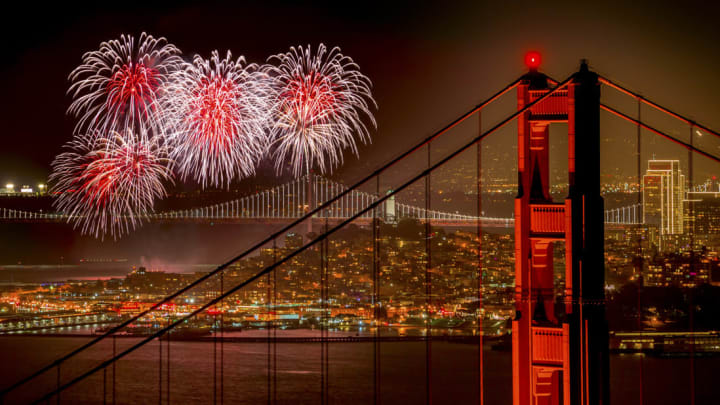by Sarah Dobbs
Each year, as the Fourth of July approaches, the sound of explosions starts to become a normal part of the evening. Fireworks have existed in one form or another for around 1000 years, and they show no signs of going away anytime soon. But how do they work? Most of us just know to light the fuse and stand back. Let’s take a closer look …
ROCKETS

Rocket-type fireworks can produce all kinds of different effects when they go off, but the basic structure of an aerial firework stays more or less the same. Each rocket is made up of the following parts: a mortar, fuses, propellant powder, a shell, a bursting charge, and a collection of "stars." The mortar is the outer container, and the fuse is, of course, the piece that you light. When the fuse burns down, the propellant ignites and shoots the firework into the air.
When it’s airborne, a second explosion is triggered inside the shell by a time delay fuse. The bursting charges set off the stars—small, explosive pellets made of fuel and metallic compounds that create the lights in the fireworks display. Different metals create different colors when they ignite: barium goes green, calcium salts go orange, magnesium goes white, copper is blue, lithium turns red, and sodium becomes gold. And the arrangement of the stars will determine the shape of the explosion—so if they’re packed in a heart shape, they should reproduce that heart shape in the sky.
Other effects can also be built in by adding various ingredients; different kinds of fuel can create sound effects, for example, like the whistling or screaming noises some rockets make as they shoot into the sky. Stars can be made up of layers of different metallic compounds, to create multicolored explosions. And in some more complex fireworks, there may be several stages of explosions; in that case, there are generally multiple fuses inside the shell, and as each burns down, a different explosive goes off.
FOUNTAINS

Of course, not all fireworks are of the shoot-into-the-air-and-go-bang variety. Fountains don’t take off, and generally don’t go bang, either; instead, they stay where they’re placed and give off a cascade of sparks—like a fountain, but with pyrotechnics instead of water.
Usually conical in shape, fountains consist of a paper or plastic tube, with clay plugs at either end. Inside the tube are a couple of different kinds of fuel, plus the metal compounds that create the sparks. When the fuse is lit, the fuel ignites, and sparks are forced out of an aperture in the top of the fountain.
Again, different metals create different colors and effects. Multi-stage effects can be created by bundling multiple tubes together, so that as one finishes another starts, adding different colors or sound effects to the display.
CATHERINE WHEELS

Catherine wheels are another common type of firework, and again the same kinds of ingredients are used to create a slightly different effect. Named for the unfortunate Saint Catherine, these fireworks are generally fixed to a pole or a mount, so that they can spin as they burn, creating a spiral of sparks.
Bigger Catherine wheels tend to have a plastic disk at their center, with “gerbs” attached around the edge. The gerbs are similar to fountains, in that they’re tubes filled with the mixture of ingredients that create the effects; when lit, the thrust from the explosives makes the wheel turn as they burn. And again, the effect can be made more elaborate with multi-stage effects and different colors; each gerb might be different, so that the wheel changes as each one ignites in turn.
Smaller Catherine wheels might, instead, be made up of a single long, thin tube coiled into shape around a smaller central disk. Again, the thrust of ignition makes the wheel spin.
SPARKLERS

The only firework you should ever hold in your hand once it’s lit is a sparkler—a Fourth of July staple. Unlike most other fireworks, they don’t explode with a bang, but gently fizzle for around a minute, as a ball of sparks makes its way down a metal wire. And they’re pretty simple: basically, the metal wire is dipped into a pyrotechnic compound that’s made up of a metallic fuel, an oxidizer, and a binding material.
The metallic fuel is what creates the sparks; it’s usually aluminum or magnesium, which creates white sparks, but some sparklers may use iron or ferrotitanium for gold sparks instead. The oxidizer, which provides the oxygen to keep the spark going, is generally potassium nitrate. And then a binding material, a kind of flammable starch, keeps the mixture together, and burns away once the sparkler is lit.
Hopefully, none of that has taken away any of the magic of a good fireworks display. If nothing else, you’ll be able to impress your friends by quietly musing “oooh, barium” next time you see a green firework.
Have you got a Big Question you'd like us to answer? If so, let us know by emailing us at bigquestions@mentalfloss.com.
